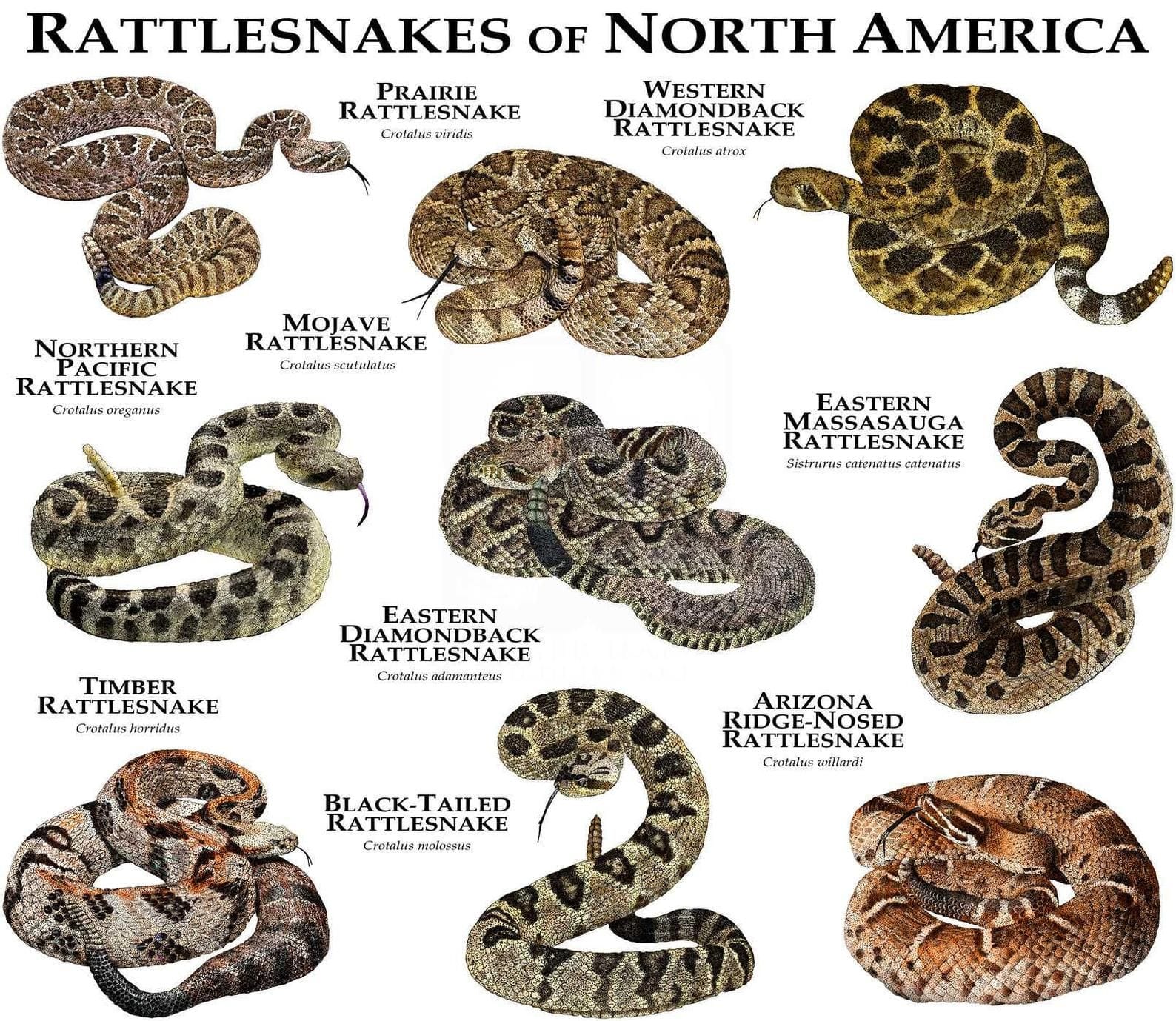If you’re curious about the world’s most fascinating venomous snakes, this guide is for you! We’ll take you on a thrilling journey into the world of rattlesnakes, from their distinctive rattles to their amazing diversity. Get ready to discover the secrets of these captivating creatures, debunk myths, and uncover the fascinating truth about their biology, behavior, and conservation status.
Unveiling the Diversity of Rattlesnakes
Rattlesnakes! Just hearing the name likely conjures up images of that chilling rattle. These incredible pit vipers, belonging to the Viperidae family, are found slithering throughout North and South America. Their most distinguishing feature? That unmistakable rattle on their tails!
Believe it or not, there are over 36 recognized species of rattlesnakes and over 65 subspecies! They range from the massive Eastern Diamondback to the petite but potent Tiger Rattlesnake. Let’s meet a few of these fascinating reptiles:
- Eastern Diamondback Rattlesnake: This is the largest venomous snake in North America, easily identified by the diamond patterns on its back. Its venom is highly potent and can be life-threatening to humans.
- Western Diamondback Rattlesnake: Venture west, and you might encounter this species, found throughout the western United States and Mexico. Like its eastern relative, it possesses potent venom.
- Timber Rattlesnake: This large, heavy-bodied snake is a sight to behold in the eastern and central United States.
- Tiger Rattlesnake: Don’t let its small size deceive you; this snake, inhabiting the southwestern United States and Mexico, has remarkably powerful venom.
- Sidewinder Rattlesnake: This desert dweller gets its name from its unique sideways movement.
- Santa Catalina Rattlesnake: This rare rattlesnake is exclusive to Santa Catalina Island and, like many island species, faces conservation challenges.
- Mexican West Coast Rattlesnake: This large and venomous species, as its name suggests, resides along the western coast of Mexico.
- Arizona Black Rattlesnake: This rattlesnake, easily identified by its dark coloration, is found in Arizona and New Mexico.
Anatomy and Behavior of Rattlesnakes
Rattlesnakes are fascinatingly designed creatures. They possess heat-sensing pits on their faces, allowing them to locate warm-blooded prey even in darkness. Their hollow, retractable fangs are ready to deliver a dose of potent venom.
Of course, the most recognizable feature is the rattle. This structure, located at the end of the tail, is made of loosely interlocking segments that create the characteristic warning sound when vibrated.
Rattlesnakes are ambush predators, lying in wait for unsuspecting prey. They primarily feed on rodents, birds, and other small animals, striking with impressive speed. Their venom, a complex blend of proteins and enzymes, breaks down tissues and disrupts blood clotting, effectively subduing their prey.
Unlike many reptiles, rattlesnakes give birth to live young. The number of offspring varies among species. And yes, these newborns arrive equipped with venom glands!
Coexisting with Rattlesnakes
Rattlesnakes play a crucial role in their ecosystems by regulating rodent populations. However, it’s essential to remember that they are wild animals and should be treated with caution and respect.
A rattlesnake bite is a serious medical emergency requiring immediate attention. Sadly, rattlesnakes are often misunderstood and persecuted out of fear. It’s crucial to remember that they typically bite defensively.
We can coexist with rattlesnakes by being aware of their presence and giving them space. If you live in rattlesnake country, take precautions like wearing boots and long pants when hiking and being mindful of where you step and reach. If you encounter a rattlesnake, give it a wide berth and allow it to move along.
Debunking Rattlesnake Myths
Several myths and misconceptions surround rattlesnakes. Let’s debunk a few:
Myth: Rattlesnakes always rattle before striking.
- Fact: While rattlesnakes often use their rattle as a warning, they may not always do so, especially if startled or feeling threatened.
Myth: Baby rattlesnakes are less dangerous than adults.
- Fact: Baby rattlesnakes are just as venomous as adults and may have less control over the amount of venom injected.
Myth: Rattlesnakes are aggressive and will chase you.
- Fact: Rattlesnakes are generally shy and prefer to avoid confrontation. They will only strike if they feel threatened or cornered.
Myth: Killing a rattlesnake is the best course of action.
- Fact: Killing rattlesnakes is not only inhumane but also disrupts the ecosystem. It can lead to an increase in rodent populations, potentially attracting more snakes.
Conservation of Rattlesnakes
Conservation efforts are vital for the long-term survival of many rattlesnake species. Habitat loss, fragmentation, human-wildlife conflict, and illegal collection for the pet trade threaten these creatures. By understanding rattlesnakes and promoting their conservation, we can help ensure these iconic reptiles continue to thrive.
Unveiling the Truth About the Most Venomous Rattlesnake
While several rattlesnakes are considered dangerous, the title of “most venomous” belongs to the Tiger Rattlesnake (Crotalus tigris), a snake whose venom surpasses even that of the deadliest vipers in the Americas.
Don’t be fooled by its small size; this snake, often measuring under 2 feet, packs a venomous punch more potent than its larger, more infamous relatives, like the Eastern Diamondback.
Venom Potency vs. Danger
The Tiger Rattlesnake holds the record for the most venomous rattlesnake and the most venomous snake native to the Americas. However, it’s essential to understand the distinction between venom potency and overall danger.
- LD50: This measure represents the lethal dose for 50% of test subjects. The Tiger Rattlesnake boasts a very low LD50, indicating high venom potency.
- Other Factors: Venom yield (the amount injected per bite), temperament (defensive vs. aggressive), fang length, and human proximity all contribute to the actual threat a rattlesnake presents.
Though crowned the most venomous, the Tiger Rattlesnake’s reclusive nature and limited habitat at higher elevations make encounters, and thus serious bites, relatively rare.
Rarest Rattlesnake Analysis: Outperforming the Competition
The title of “rarest rattlesnake” belongs to the Ridge-nosed Rattlesnake (Crotalus willardi). These snakes are incredibly particular about their homes, preferring very specific locations in the southwestern United States, mainly in parts of Arizona and New Mexico.
A Closer Look at the Ridge-nosed Rattlesnake
- Size: The Ridge-nosed Rattlesnake is the smallest rattlesnake species, averaging only about a foot in length.
- Range: Their range is highly limited and fragmented, making them even more vulnerable.
- Threats: Habitat loss and fragmentation due to human activities pose significant threats to their survival.
While Eastern Diamondbacks grab headlines for their size, the tiny Ridge-nosed Rattlesnake faces outsized threats to its survival. Conservation efforts are crucial for protecting this unique species and its habitat.
How Many Types of Rattlesnakes are in the US?
The United States is home to a remarkable diversity of rattlesnakes. While there are 36 officially recognized species, the exact number is often debated due to the existence of numerous subspecies.
Understanding Rattlesnake Classification
- Species vs. Subspecies: The existence of around 83 subspecies of rattlesnakes, grouped into the genera Crotalus and Sistrurus, contributes to varying estimates (30-60) often encountered online.
- Northeastern US: It’s interesting to note that rattlesnakes haven’t colonized every corner of the US Certain states, mainly those in the northeast, lack any native rattlesnake species.
The Importance of Rattlesnake Conservation
Rattlesnakes, though often feared, play a crucial role as apex predators in their ecosystems. They help regulate rodent populations, which is essential for maintaining a healthy balance. Understanding their diversity is vital for both conservation efforts and minimizing human-wildlife conflict.
By appreciating these fascinating creatures and advocating for their protection, we can ensure that rattlesnakes continue to thrive in their natural habitats for generations to come.
Remember, if you’re ever in an area inhabited by rattlesnakes, be sure to pack an Athleta backpack for your adventures and brush up on your beardie names – you never know when you might need a new moniker for a reptilian friend!
- Discover Long Black Pepper: Flavor & Health Benefits - April 25, 2025
- Shocking Twists: The Grownup Review: Unreliable Narration - April 25, 2025
- A Quiet Place Book vs Movie: A Deep Dive - April 25, 2025
















